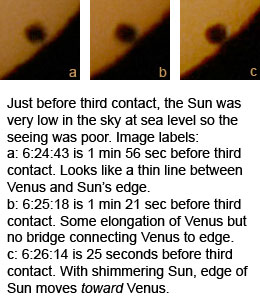
(select image to reduce size of picture)
First four images from the summit of Mauna Kea. Fifth image from the Visitor Information Station at Mauna Kea. Last three images from the beach at the Marriott Waikoloa Beach Resort since a low cloud bank in western sky at Mauna Kea would have blocked Sun at third and fourth contacts. Images were rotated to adjust for the parabolic arc of the Sun across the sky. You can definitely see the black-drop effect (described more below) and the effect of air turbulence (poor seeing) when viewing the Sun low in the sky at sea level.
The black-drop effect is a small, black extension that appears to connect Venus' disk to the edge of the Sun when Venus is just inside the edge of the Sun. It results from diffraction effects that are the result of the wave nature of light as the light passes through an aperture plus the darkening of the Sun toward its edge ("solar limb darkening") that results from a combination of the density and the temperature of the Sun being lower closer to the surface than deeper in the Sun. You can see the same sort of diffraction effect by holding your thumb and your index finger very close together but not touching. Just before they touch, you'll notice a dark space appear between the finger and thumb. Although Kurtz, et al note that the black-drop can explained just with diffraction and solar limb darkening, the turbulence of the Earth's air (seeing effects) can pronounce it as shown in the figures below.
The first sequence below was taken from the summit of Mauna Kea as Venus was fully on the face of the Sun (second contact). The Sun was high in the sky so the air turbulence was minimized but still there. At 23 seconds after second contact, it looks like Venus has finally passed the edge of the Sun but at another five seconds, it looks like some sort of bridge between Venus' edge and the Sun's edge returns. Can you see why it would be so difficult for observers to agree on the exact time of second contact?

The sequences below are taken from sea level when the Sun was less than 22 degrees above the horizon. The air turbulence is much greater (seeing is much poorer) at this time so the black-drop effect will be more pronounced. At almost two minutes before third contact it looks like there is a thin line of darkness connecting the Venus and the edge of the Sun. There are drawings from the 1874 transit of Venus showing the same thin black line (one set of drawings from M. Allerding shows this and see also drawings collected by Guido H D'Arturo for his 1922 paper on the black-drop effect). The thin line disappears about 30 seconds later and another black-drop connection appears almost a minute later. Clearly, the Earth's atmosphere pronounces the black-drop effect: the poorer the seeing, the more dramatic is the black-drop effect. Can you see why it would be so difficult for observers to agree on the exact time of third contact?

Posted to Astronomy Notes: October 11, 2014 (Page last updated: August 13, 2012 -- links were correct at that time)